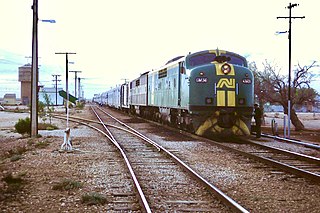
The Ghan is an experiential tourism-oriented passenger train service that operates between the northern and southern coasts of Australia, through the cities of Adelaide, Alice Springs and Darwin on the Adelaide–Darwin rail corridor. Operated by Journey Beyond Rail Expeditions, its scheduled travelling time, including extended stops for passengers to do off-train tours, is 53 hours 15 minutes to travel the 2,979 kilometres (1,851 mi). The Ghan has been described as one of the world's great passenger trains.

The Indian Pacific is a weekly experiential tourism passenger train service that runs in Australia's east–west rail corridor between Sydney, on the shore of the Pacific Ocean, and Perth, on the shore of the Indian Ocean – thus, like its counterpart in the north–south corridor, The Ghan, one of the few truly transcontinental trains in the world. It first ran in 1970 after the completion of gauge conversion projects in South Australia and Western Australia, enabling for the first time a cross-continental rail journey that did not have a break of gauge.

The Overland is an Australian passenger train service between the state capitals of Melbourne and Adelaide, a distance of 828 km (515 mi). It first ran in 1887 as the Adelaide Express, known by South Australians as the Melbourne Express. It was given its current name in 1936. Now operated by private company Journey Beyond, the train undertakes two return trips a week. Originally an overnight train that stopped at large intermediate stations, it now operates during the day, stopping less frequently.

Adelaide Parklands Terminal, formerly known as Keswick Terminal, is the interstate passenger railway station in Adelaide, South Australia. It is the only station in the world where passengers can board trains on both north–south and east–west transcontinental routes.

Journey Beyond is the business name of Experience Australia Group Pty Ltd, a private-equity-owned company, known mainly for operating Australian interstate experiential tourism trains. As of December 2021, the company was a diversified tourism business based in Adelaide, South Australia, with interests in cruise and air tourism in addition to rail. In January 2022, the United States travel company the Hornblower Group acquired the business from Quadrant Private Equity, which had owned it since 2016.

3801 is a 4-6-2 steam locomotive operated by the New South Wales Government Railways between 1943 and 1974. It is arguably Australia's most famous steam locomotive, being the only one to have visited all mainland states and territories.

The Australian National Railways Commission was an agency of the Government of Australia that was a railway operator between 1975 and 1998. It traded as Australian National Railways (ANR) in its early years, before being rebranded as Australian National. AN was widely used from 1980, the logotype being registered as a trade mark.

The Commonwealth Railways were established in 1917 by the Government of Australia with the Commonwealth Railways Act to administer the Trans-Australia and Port Augusta to Darwin railways. It was absorbed into Australian National in 1975.

The AN class are a class of diesel locomotives built by Clyde Engineering, Somerton for Australian National in 1992–1993.

One Rail Australia was an Australian rail freight operator company. Founded by a United States short line railroad holding company, Genesee & Wyoming Inc, in 1997 as Australian Southern Railroad, and successively renamed Australian Railroad Group and Genesee & Wyoming Australia, it was renamed One Rail Australia in February 2020 after the American company sold its remaining shareholding. In July 2022, assets from the South Australian, Northern Territory and interstate operations of the company were sold to rail operator company Aurizon Holdings Limited. The remaining assets, relating to coal haulage in New South Wales and Queensland, were sold in February 2023 to Magnetic Rail Group.

The Southern Aurora was an overnight express passenger train that operated between Australia's two largest cities, Sydney and Melbourne. First-class throughout, including the dining facilities, the Southern Aurora featured all-sleeper accommodation. The train first ran on 13 April 1962 after the opening of the North East standard gauge line from Melbourne to Albury, eliminating the break-of-gauge between the capital cities.

The Sydney–Perth rail corridor is a 1435 mmstandard gauge railway route that runs for 4352 kilometres (2704 mi) across Australia from Sydney, New South Wales, to Perth, Western Australia. Most of the route is under the control of the Australian Rail Track Corporation.

The CL class is a class of diesel locomotives built by Clyde Engineering, Granville for the Commonwealth Railways in several batches between 1970 and 1972. The class was the last in the world to be built with the Electro-Motive Diesel bulldog nose but differed from previous builds in having a mansard roof.

Alice Springs railway station is located on the Adelaide–Darwin railway in Alice Springs.

The L Class are a class of diesel locomotives built by Clyde Engineering, Granville and Eagle Farm, and Commonwealth Engineering, Rocklea for the Western Australian Government Railways between 1967 and 1973.

The Bluebird railcars were a class of self-propelled diesel-hydraulic railcar built by the South Australian Railways' Islington Railway Workshops between 1954 and 1959.

The Trans-Australian was an Australian passenger train operated by the Commonwealth Railways initially between Port Augusta and Kalgoorlie on the Trans-Australian Railway line, and later extended west to Perth, and east to Port Pirie and Adelaide.

In July 1965, Commonwealth Railways placed an order with Commonwealth Engineering, Granville for eight 22.92-metre air-conditioned stainless steel sleeping carriages and one dining carriage for use on the Trans Australian. The first was delivered in July 1966.

Port Pirie railway station (Mary Elie Street) was the fifth of six stations that operated at various times from 1876 to serve the small maritime town (later city) of Port Pirie, 216 kilometres (134 miles) by rail north of Adelaide, South Australia. As with several of Port Pirie's other stations before it, the station was built to accommodate a change of track gauge on railway lines leading into the town.
The Marree railway line is located in the Australian state of South Australia.



















